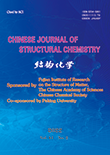Synthesis, Structures, Luminescence and Catalytic Activity in the Knoevenagel Condensation Reaction of Two Cd(II) Coordination Polymers Based on a Biphenyl-dicarboxylic Acid
WU Jiang* and GU Jin-Zhong*
Chin. J. Struct. Chem. 2022, 41, 2202034-2202042 DOI: 10.14102/j.cnki.0254-5861.2011-3250
February 15, 2022
coordination polymer, dicarboxylic acid, luminescence, catalytic properties, Knoevenagel condensation reaction
ABSTRACT
Two
cadmium coordination polymers, namely [Cd(μ-dda)(H2biim)]n (1) and [Cd(μ4-dda)(py)]n (2) have been constructed hydrothermally using H2dda (H2dda
= 4,4΄-dihydroxybiphenyl-3,3΄-dicarboxylic
acid), H2biim (H2biim = 2,2΄-biimidazole), py (py = pyridine),
and cadmium chloride at 160 °C. The products were isolated as stable
crystalline solids and were characterized by IR spectra, elemental analyses,
thermogravimetric analyses (TGA), and single-crystal X-ray diffraction
analyses. Single-crystal X-ray diffraction analyses revealed that both
compounds crystallize in the monoclinic system,
space group C2/c. Compound 1 discloses a 1D chain structure. Compound 2 features a 3D framework. The
luminescent properties of compounds 1 and 2 were evaluated. Besides, the catalytic
activities in the Knoevenagel condensation reaction of two compounds were
investigated. Compound 1 exhibits an excellent catalytic activity in the Knoevenagel
condensation reaction at room temperature.








